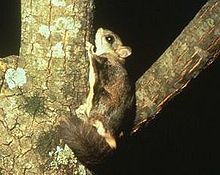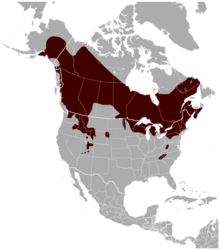
Back جلوكوميس سابرينوس ARZ Glaucomys sabrinus AST قلاوکومیس سابرینوس AZB Северноамериканска летяща катерица Bulgarian Gwiñver-nij an norzh Breton Esquirol volador d'Amèrica septentrional Catalan Glaucomys sabrinus CEB Poletuška severní Czech Nördliches Gleithörnchen German Glaucomys sabrinus Spanish
| Northern flying squirrel | |
|---|---|

| |
| Scientific classification | |
| Domain: | Eukaryota |
| Kingdom: | Animalia |
| Phylum: | Chordata |
| Class: | Mammalia |
| Order: | Rodentia |
| Family: | Sciuridae |
| Genus: | Glaucomys |
| Species: | G. sabrinus
|
| Binomial name | |
| Glaucomys sabrinus (Shaw, 1801)
| |
| Subspecies | |
|
see text | |

| |
| Northern flying squirrel range[1](excludes Glaucomys oregonensis) | |
The northern flying squirrel (Glaucomys sabrinus) is one of three species of the genus Glaucomys, the only flying squirrels found in North America.[2][3] They are found in coniferous and mixed coniferous forests across much of Canada, from Alaska to Nova Scotia, and south to the mountains of North Carolina and west to Utah in the United States. They are light brown with pale underparts and grow to a length of 25 to 37 cm (10 to 15 in). They are proficient gliders but uncoordinated walkers on the ground. They feed on a variety of plant material as well as tree sap, fungi, insects, carrion, bird eggs and nestlings. They mostly breed once a year in a cavity lined with lichen or other soft material. Except when they have young, they change nests frequently, and in winter a number of individuals may huddle together in a shared nest. Unlike most members of their family, flying squirrels are strictly nocturnal.
- ^ a b Cassola, F. (2016). "Glaucomys sabrinus". IUCN Red List of Threatened Species. 2016: e.T39553A22256914. doi:10.2305/IUCN.UK.2016-3.RLTS.T39553A22256914.en. Retrieved 11 November 2021.
- ^ Walker EP, Paradiso JL. 1975. Mammals of the World. Baltimore: Johns Hopkins University Press.
- ^ Forsyth A. 1999. Mammals of North America: Temperate and Arctic Regions. Willowdale: Firefly Books.
